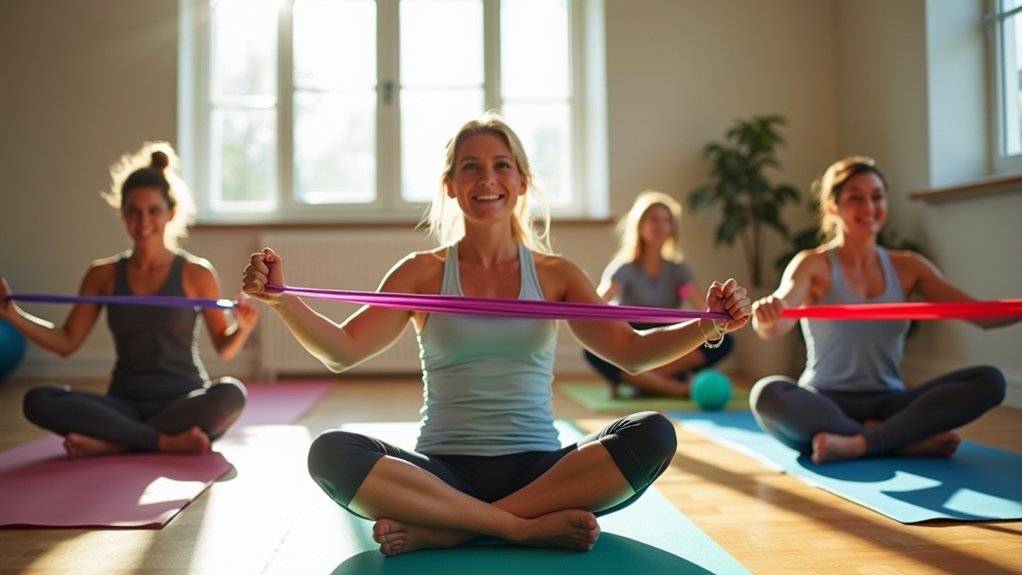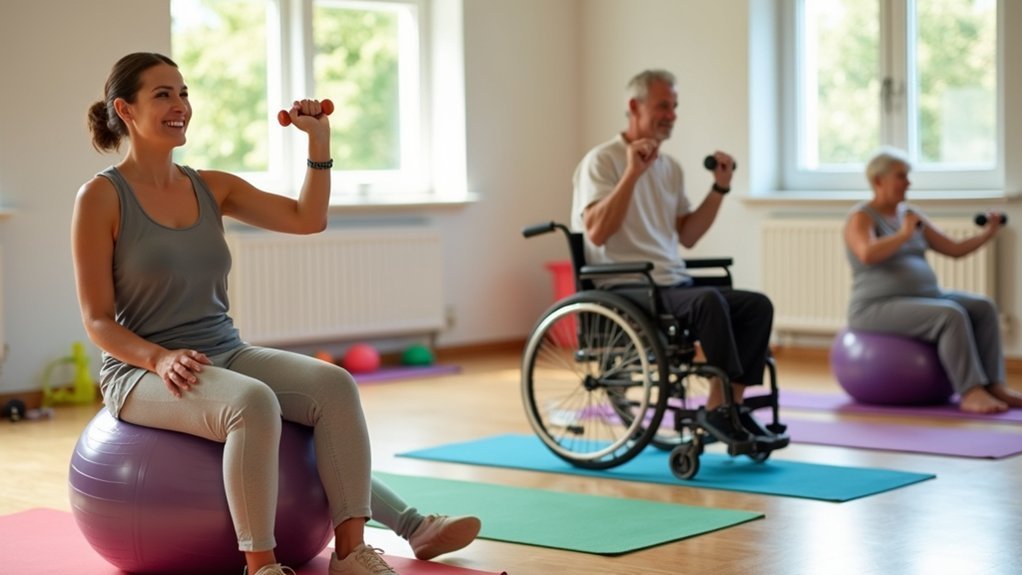You can maintain fitness with limited mobility through chair-based cardiovascular movements like seated marching and arm circles, upper body strength training using light weights or resistance bands, and gentle stretching routines that improve flexibility. Water-based exercises reduce joint stress while building strength, while isometric holds engage muscles without movement. Balance drills with support, adaptive yoga poses, and low-impact aerobic movements round out your options. Discover how these targeted exercises can transform your fitness routine.
Chair-Based Cardiovascular Movements

While traditional cardio exercises might seem out of reach when you have limited mobility, chair-based cardiovascular movements offer an excellent alternative that’ll get your heart pumping without requiring you to stand or walk.
These chair exercises include seated marching, arm circles, leg lifts, and torso twists that effectively elevate your heart rate while improving circulation and flexibility. You’ll burn calories and boost your cardiovascular health without risking falls or excessive joint strain.
Adding resistance bands increases intensity and builds strength safely. Start with manageable sessions and aim for 150 minutes weekly, gradually increasing duration and intensity as your endurance improves.
These movements accommodate limited mobility while delivering genuine aerobic benefits.
Upper Body Strength Training From Seated Position
When you’re ready to build upper body strength from your chair, you’ll discover that targeted exercises can effectively develop your shoulders, arms, and chest without putting any stress on your lower body.
Light weights or resistance bands work perfectly for individuals with limited mobility who want to maintain their fitness routine from a seated position.
Start with seated bicep curls, shoulder presses, and arm circles to engage multiple muscle groups safely. You’ll need to maintain proper posture throughout each exercise—keep your back straight and engage your core to prevent injury while maximizing effectiveness.
Begin with manageable weights and gradually increase resistance as your upper body strength improves.
These exercises will enhance your daily functional movements, boost coordination, and build endurance over time.
Gentle Stretching and Flexibility Routines

Gentle stretching routines complement your strength training by improving flexibility and reducing the stiffness that often accompanies limited mobility. You can perform these exercises safely from your chair, making them accessible regardless of your standing ability.
Flexibility exercises like yoga and tai chi don’t just enhance your range of motion—they also alleviate stress and anxiety while promoting mental well-being.
Simple movements such as neck circles and spinal twists stimulate blood flow and ease muscle tension, improving your posture and comfort.
Regular stretching prevents injury and reduces muscular atrophy by maintaining muscle elasticity and strength. You’ll find that consistent practice considerably improves your overall flexibility while keeping your muscles active and healthy.
Water-Based Exercise Alternatives
As you explore exercise options beyond land-based routines, water-based activities offer exceptional benefits for people with limited mobility. Water’s buoyancy reduces joint stress considerably, making swimming and water aerobics ideal choices when arthritis or mobility challenges limit your movement options.
Water’s buoyancy reduces joint stress, making aquatic exercises perfect for those with arthritis or mobility limitations.
You’ll find water’s natural resistance provides effective strength training without requiring weights, engaging your muscles thoroughly while staying safe. These exercises improve your cardiovascular health, flexibility, and strength simultaneously.
The soothing properties of water also promote relaxation and reduce anxiety during workouts. Most community centers offer specialized classes designed for mobility challenges, creating supportive environments.
Regular participation increases your range of motion and improves physical function, making daily tasks easier and enhancing your overall quality of life.
Resistance Band Workouts for Limited Range

You’ll find resistance bands offer incredible versatility for strength training when your mobility is restricted.
Upper body band exercises let you target your arms, shoulders, and chest effectively while working within your comfortable range of motion.
Seated band movements enable you to perform a full workout from your chair or wheelchair, making fitness accessible regardless of your physical limitations.
Upper Body Band Exercises
While traditional weightlifting might seem out of reach, resistance bands offer a versatile solution that adapts perfectly to your current mobility level. These bands provide adjustable resistance levels, allowing you to gradually increase intensity as your strength improves.
You can perform effective upper body workouts while seated or standing, making them ideal for individuals with limited mobility.
Key benefits of upper body resistance band exercises include:
- Enhanced muscle tone and endurance for daily activities
- Improved joint stability and coordination
- Reduced injury risk through controlled movements
- Better functional independence over time
Common exercises like seated bicep curls, shoulder presses, and lateral raises target major muscle groups effectively.
Regular engagement with resistance bands promotes strength and flexibility while maintaining your safety and comfort throughout each workout session.
Seated Band Movements
Seated band movements transform your chair into a complete fitness station, enabling you to target every major muscle group without compromising stability or comfort.
These resistance exercises perfectly accommodate individuals with limited mobility, offering adjustable tension that grows with your strength progression.
You’ll master fundamental movements like seated rows for back development, chest presses for upper body power, and leg extensions for lower body conditioning. Each exercise engages your core while maintaining controlled resistance throughout the entire range of motion.
The beauty of seated band movements lies in their versatility and safety. You’re building muscle tone, enhancing flexibility, and supporting rehabilitation goals simultaneously.
Regular practice maintains functional strength, improves daily mobility, and contributes greatly to your overall physical well-being without requiring complex equipment or extensive space.
Breathing Exercises Combined With Light Movement
Since breathing forms the foundation of all movement, combining controlled breathing techniques with gentle exercises creates a powerful synergy that maximizes the benefits of your workout routine.
Controlled breathing paired with gentle movement creates a foundation that amplifies every aspect of your fitness journey.
When you have mobility issues, breathing exercises paired with light movement offer an accessible way to enhance your physical and mental well-being without straining your body.
This combination helps you:
- Improve lung capacity – Deep breathing while performing arm circles or seated leg lifts enhances oxygenation throughout your body
- Reduce stress levels – Rhythmic breathing during gentle movements promotes relaxation and calms your nervous system
- Increase coordination – Synchronized breathing and movement patterns help develop better body awareness and control
- Boost circulation – Consistent practice enhances blood flow and reduces stiffness in joints and muscles
Balance and Coordination Drills While Supported
Even when your mobility is limited, you can develop better balance and coordination through supported exercises that prioritize safety while challenging your body’s control systems.
These supported exercises use chairs or walls as stability aids, allowing you to focus on movement quality without fear of falling.
Start with seated leg lifts and arm raises, engaging your core while maintaining proper posture.
Add rhythmic movements like marching in place or tapping patterns to enhance coordination.
Resistance bands create additional challenges while you remain safely supported.
Practice these balance and coordination drills regularly to improve motor control and reduce fall risk.
Simple movements performed consistently build strength and stability, proving that limited mobility doesn’t prevent meaningful fitness progress when you use appropriate support systems.
Isometric Exercises for Muscle Engagement
You can build significant strength through isometric exercises that contract your muscles without requiring joint movement or position changes.
These static holds allow you to engage major muscle groups while seated or lying down, making them perfect when traditional exercises aren’t feasible.
You’ll discover that holding positions like wall pushes or seated leg contractions for 10-30 seconds creates meaningful muscle engagement and improved stability over time.
Static Hold Benefits
When you’re dealing with limited mobility, isometric exercises offer a powerful way to build strength without putting stress on your joints. Static holds engage your muscles while keeping them stationary, making them perfect for safe, effective workouts.
The benefits of incorporating static holds into your routine include:
- Enhanced muscle strength – Research demonstrates these exercises build strength as effectively as traditional weight training
- Improved circulation – Sustained muscle engagement boosts blood flow and reduces stiffness
- Better stability – Static holds increase muscle endurance and improve overall balance
- Mental wellness – Controlled breathing and focused muscle engagement reduce stress while improving concentration
You’ll find that static holds provide extensive benefits without requiring complex movements or equipment.
Seated Muscle Contractions
Since seated muscle contractions require nothing more than a sturdy chair, they’re among the most accessible strength-building exercises available. These isometric exercises engage your muscles without movement, making them perfect for individuals with limited mobility who want to maintain strength safely.
You’ll strengthen your arms, legs, and core while remaining comfortably seated. These contractions improve muscle endurance and stability while boosting circulation and preventing muscle atrophy.
| Exercise | Target Area | Technique |
|---|---|---|
| Palm Press | Arms/Chest | Press palms together firmly |
| Knee Squeeze | Inner Thighs | Squeeze cushion between knees |
| Abdominal Tightening | Core | Contract stomach muscles |
Incorporating seated muscle contractions into your exercise routine enhances physical well-being with minimal exertion required.
Adaptive Yoga Poses for Restricted Mobility
Although traditional yoga poses might seem impossible with restricted mobility, adaptive modifications transform this ancient practice into an accessible form of exercise that works with your body’s current abilities.
Adaptive yoga poses for limited mobility can improve flexibility while accommodating your specific needs through creative modifications.
You can practice effectively using supportive equipment:
- Chairs and props – Seated forward bends and gentle twists maintain yoga’s benefits without requiring full range of motion
- Wall support – Use sturdy furniture or walls for balance during standing poses to guarantee safety
- Breathing techniques – Focus on deep breathing to enhance oxygen flow and reduce anxiety
- Regular practice – Build strength and mental well-being through consistent adaptive sessions
These modifications make yoga’s stress-reducing and flexibility-enhancing benefits accessible regardless of mobility restrictions.
Low-Impact Aerobic Movements
While yoga focuses on flexibility and mindfulness, low-impact aerobic movements target your cardiovascular system to strengthen your heart and boost endurance without straining your joints.
Chair aerobics and seated marching effectively raise your heart rate while accommodating limited mobility. You’ll want to aim for 150 minutes weekly to enhance mood and energy levels considerably.
Chair-based exercises deliver cardiovascular benefits while respecting mobility limitations, making 150 weekly minutes both achievable and mood-boosting.
Water aerobics offers exceptional benefits by reducing joint discomfort while providing muscle-strengthening resistance. The buoyancy supports your body weight, making movement easier and more comfortable.
Simple exercises like arm circles and leg lifts serve as excellent low-impact exercises that improve mobility and flexibility.
Incorporating these movements into daily routines promotes consistent physical activity, leading to improved blood circulation and reduced chronic disease risks while building cardiovascular health safely.
Frequently Asked Questions
What Is the Best Exercise for People With Limited Mobility?
You’ll find water aerobics offers the best overall benefits since water’s buoyancy reduces joint stress while providing resistance for strengthening. It’s gentle, effective, and improves cardiovascular health safely.
What Exercises Are Good for Impaired Physical Mobility?
You’ll benefit from chair exercises like seated leg lifts, gentle yoga stretches, and resistance band training. Water aerobics provides excellent low-impact cardio, while short 10-minute activity sessions can greatly improve your strength and flexibility.
What Can a Person With Very Limited Mobility Do to Keep Active?
You can stay active through seated exercises like arm circles and leg lifts, water aerobics for joint-friendly movement, resistance band workouts, daily stretching routines, and deep breathing exercises to maintain physical and mental well-being.
What Is the Best Exercise if You Can’t Walk?
You’ll find water aerobics provides the best overall exercise when you can’t walk. The buoyancy supports your body while reducing joint stress, allowing effective cardiovascular workouts and muscle strengthening simultaneously.





Leave a Reply